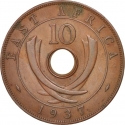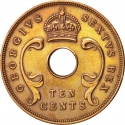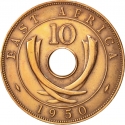You are about to finish your registration. Please check your mailbox (including spam folder). There should be a letter with a confirmation link. Check setting to make sure that your e-mail address is correct.
Send letter againDescription
East Africa Protectorate (also known as British East Africa) was an area in the African Great Lakes occupying roughly the same terrain as present-day Kenya from the Indian Ocean inland to Uganda and the Great Rift Valley. It was an administrative grouping of five separate British territories: Kenya, Uganda, the Sultanate of Zanzibar and British Somaliland.
By 1964 all the three countries of East Africa: Uganda, Tanzania (Tanganyika) & Kenya had not only become independent but also became Republic i.e. the President is the head of state. This scenario was also reflected in the coins that were minted in 1964 wherein the British Crown has been removed. All earlier coins i.e. till 1963 had the crown to symbolise the Queen of England was also the head of state (Commonwealth realm) of these countries.
Kenya was the last to become Republic in December 1964. Hence coins with & without crown (KM# 40) is minted in 1964. Coins without crown were released in Uganda & Tanganyika for circulation and with the crown in Kenya.
Obverse

|
The Tudor Crown, value and lettering. QUEEN ELIZABETH THE SECOND |
|---|---|
Reverse

|
Tusks flank center hole, denomination above, circle surrounds. EAST AFRICA |
| Edge |
10 Cents
KM# 38 Schön# 39
Characteristics
| Material | Bronze |
| Weight | 9.36 g |
| Diameter | 30 mm |
| Thickness | - |
| Shape |
|
| Alignment | Medal |
| Mints |
Heaton Mint, Birmingham (H) Royal Mint
|





